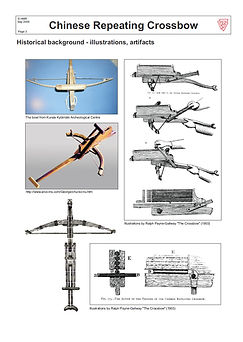
WOODWORKS - A REPEATING CROSSBOW
The repeating crossbow (Chinese: 連弩; pinyin: Lián Nŭ), also known as the Zhuge crossbow (Chinese: 諸葛弩; pinyin: Zhūgé nǔ, previously romanized Chu-ko-nu) due to the design upgrade contributed by Three Kingdoms-era strategist Zhuge Liang (181—234 AD), is an ancient Chinese crossbow where the separate actions of stringing the bow, placing the bolt and shooting it can be accomplished with a simple one-handed movement while keeping the crossbow stationary. This allows a higher rate of fire than a normal crossbow: there is a top-mounted magazine containing a reservoir of bolts that are fed by gravity, and the mechanism is worked by simply moving a rectangular lever forward and backward. (Wikipedia)

The crossbow is based on historical data and archeological finds, but the actual realization is not an accurate copy. A new artistic, fantasy-inspired but theoretically historic look was designed.
The crossbow is fully working, deadly weapon. It can empty the 10-arrow magazine in five seconds, all of them hitting a man-sized target from 20 metres away. The arrows penetrate about 10mm of solid wood.



The bow is constructed of mahogany and ash wood, with bone inlays and brass and forged iron parts. The bowstring is dacron for durability and safety, the only non-historical material in the weapon. The string release nut is moose horn with steel reinforcement. The ropes are oil-treared hemp. The wooden parts are beeswaxed.




The aspiration of design was to create an eastern historical look with "sexiness added", as is common in movie prop design. A combination of very dark wood for the stock and light wood for other parts was selected as a coloration. The bow was known to be ash, so this was an easy choise. As the lever has quire a high stress, metal reinforcement was needed. Most parts are completely hard-formed, excluding the turned brass bars. The decoration in brass surfaces is made with acid etching.





The most difficult parts to make were the bone inlays. Bone is very hard and unflexible material that has to be shaped to exactly fit the base. In addision bone is harmful, so protective gear must be worn at all times. Ready bone parts were glued to the wood.
Extensive research into repeating crossbows were made before starting the project. The Archeological Expreriment Workshop of the Provincial Museum of Southwest Finland was great help and I wish to especially thank master archeologist Markku Ikäheimo.



